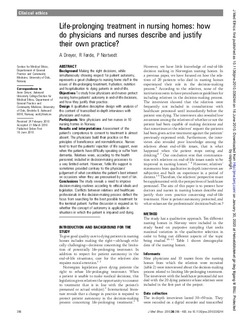| dc.contributor.author | Dreyer, Anne | |
| dc.contributor.author | Førde, Reidun | |
| dc.contributor.author | Nortvedt, Per | |
| dc.date.accessioned | 2020-01-30T13:34:58Z | |
| dc.date.available | 2020-01-30T13:34:58Z | |
| dc.date.issued | 2010 | |
| dc.identifier.citation | Dreyer, A., Førde, R. og Nortvedt, P. (2010): Life-prolonging treatment in nursing homes: how do physicians and nurses describe and justify their own practice? 396 J Med Ethics 2010; 36:396e400. | nb_NO |
| dc.identifier.uri | http://hdl.handle.net/11250/2638923 | |
| dc.description.abstract | Background Making the right decisions, while simultaneously showing respect for patient autonomy, represents a great challenge to nursing home staff in the issues of life-prolonging treatment, hydration, nutrition and hospitalisation to dying patents in end-of-life.
Objectives To study how physicians and nurses protect nursing home patients' autonomy in end-of-life decisions, and how they justify their practice.
Design A qualitative descriptive design with analysis of the content of transcribed in-depth interviews with physicians and nurses.
Participants Nine physicians and ten nurses in 10 nursing homes in Norway.
Results and interpretations Assessment of the patient's competence to consent to treatment is almost absent. The physicians build their practice on the principles of beneficence and nonmaleficence. Nurses tend to trust the patients' rejection of life support, even when the patients have difficulty speaking or suffer from dementia. Relatives were, according to the health personnel, included in decision-making processes to a very limited extent. However, futile life support is sometimes provided contrary to the physicians' judgement of what constitutes the patient's best interest on occasions when they are pressurised by next of kin.
Conclusions The study reveals a need to improve decision-making routines according to ethical ideals and legislation. Conflicts between relatives and healthcare professionals in the decision-making process deflect the focus from searching for the best possible treatment for the terminal patient. Further discussion is required as to whether the concept of autonomy is applicable in situations in which the patient is impaired and dying. | nb_NO |
| dc.publisher | Journal of Medical Ethics | nb_NO |
| dc.subject | life-prolonging treatment | nb_NO |
| dc.subject | nursing homes | nb_NO |
| dc.subject | practice | nb_NO |
| dc.subject | palliasjon | nb_NO |
| dc.subject | palliativ omsorg | nb_NO |
| dc.title | Life-prolonging treatment in nursing homes: how do physicians and nurses describe and justify their own practice? | nb_NO |
| dc.type | Journal article | nb_NO |
| dc.source.pagenumber | 396-400 | nb_NO |
| dc.source.volume | 36 | nb_NO |
| dc.source.journal | Journal of Medical Ethics | nb_NO |
| dc.source.issue | 7 | nb_NO |
| dc.identifier.doi | http://dx.doi.org/10.1136/jme.2010.036244 | |
| dc.description.localcode | måsjekkes | |
